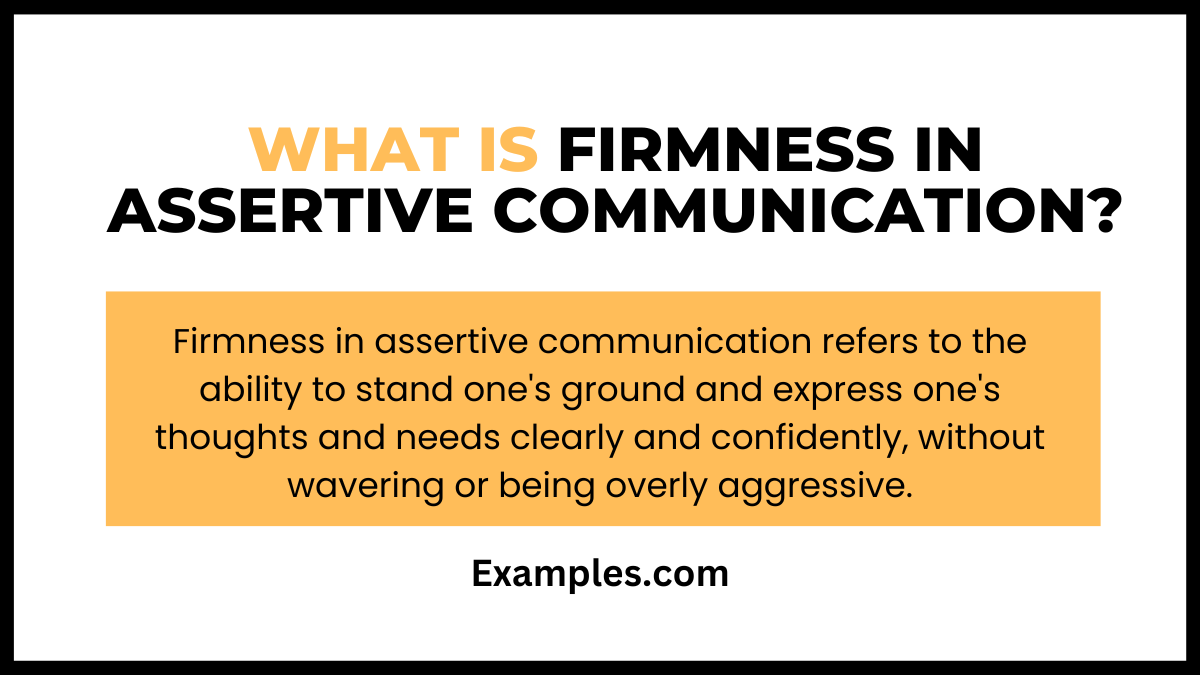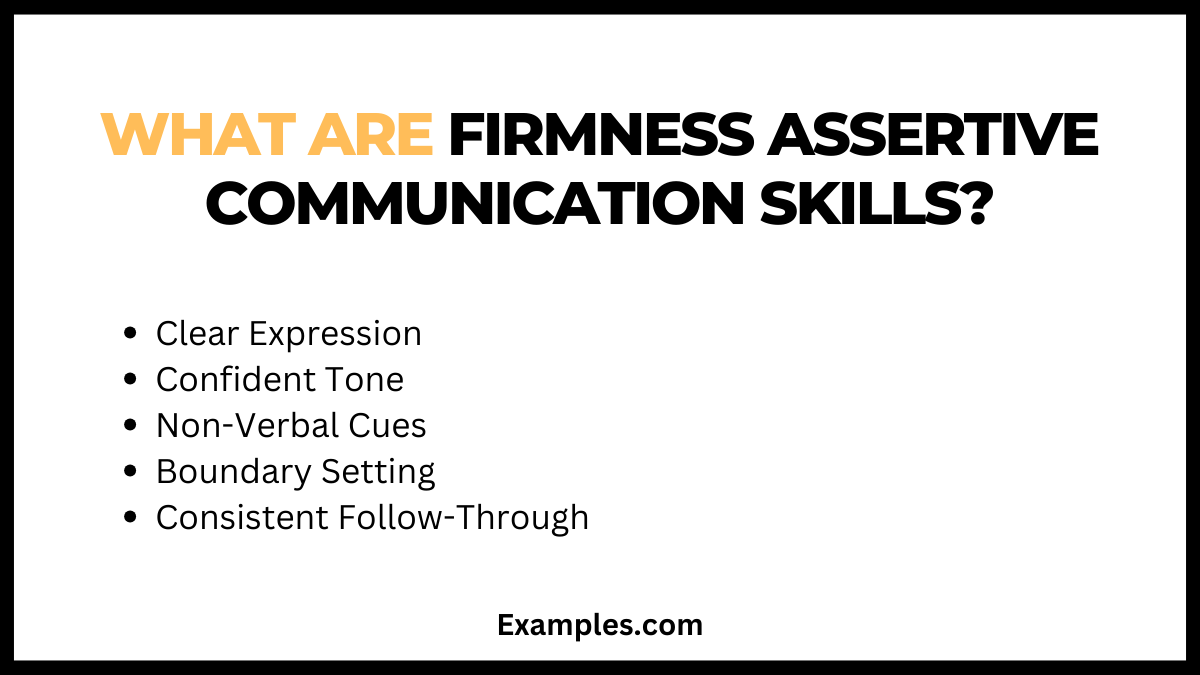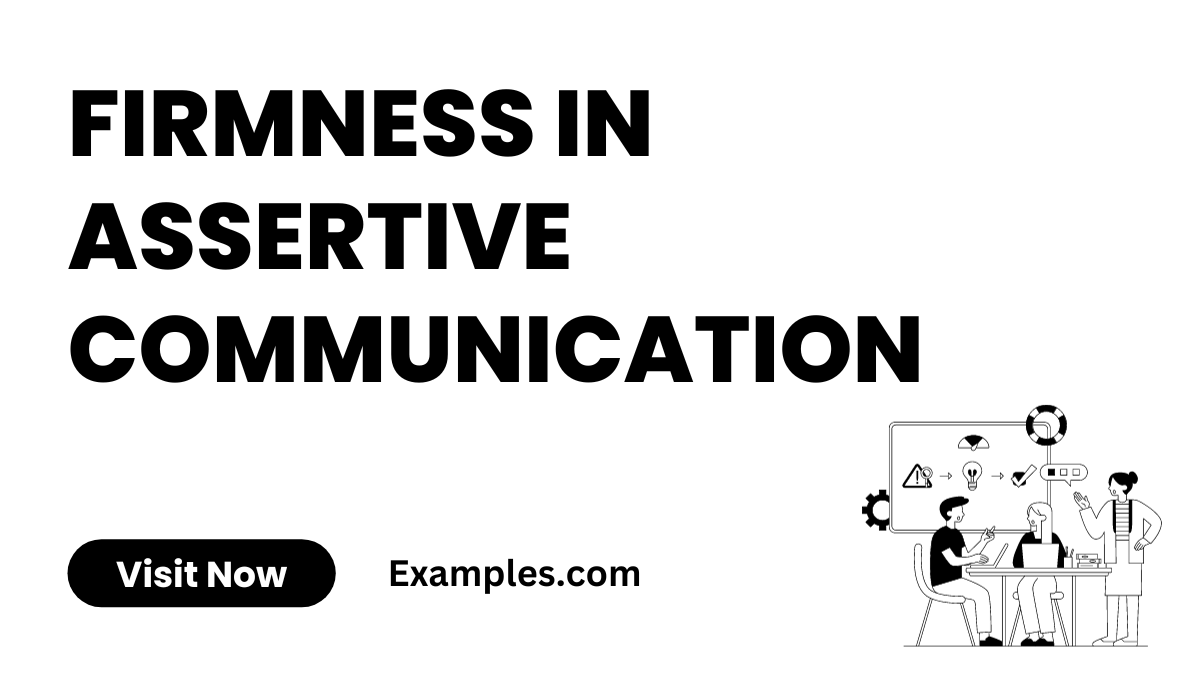29+ Firmness in Assertive Communication Examples
Navigating Assertiveness with This guide delves into the essential aspect of firmness in assertive communication, complete with practical communication examples. We explore how to express oneself firmly, ensuring messages are conveyed with clarity and determination, while still maintaining respect and empathy towards others. Firmness in communication is not about dominance; it’s about self-assured expression and respecting personal boundaries. This guide offers insights and strategies to help you communicate your needs and opinions confidently, without crossing into aggressiveness, thereby enhancing interpersonal relationships and self-expression.
What is Firmness in Assertive Communication?

Firmness in assertive communication refers to the ability to stand one’s ground and express one’s thoughts and needs clearly and confidently, without wavering or being overly aggressive. This communication skill is about maintaining a strong, steady presence, ensuring that your message is not only heard but also taken seriously. It involves a balanced approach of being direct and clear in your communication while remaining respectful and considerate of others. Firmness in this context is not about dominance but about being steadfast in your convictions and effectively conveying your point of view in a composed and self-assured manner.
30 Firmness in Assertive Communication Examples
In the realm of effective communication, firmness plays a pivotal role. This guide presents 30 distinct examples of firmness in assertive communication, each accompanied by an explanation. These examples demonstrate how to convey your message with conviction and clarity, without compromising respect or empathy.
1. “I need this report by tomorrow morning, please ensure it’s on my desk.”
Demonstrates clear, direct instructions without being harsh, showing assertiveness in a professional setting.
2. “I understand your point, but I disagree. Here’s my perspective…”
Illustrates disagreeing respectfully, maintaining one’s stance while acknowledging the other’s viewpoint.
3. “I appreciate your help, but I would like to do this task myself.”
Shows polite refusal, asserting independence while valuing the other’s offer to assist.
4. “No, I cannot attend the meeting at that time. Can we reschedule?”
A firm refusal coupled with a solution, balancing assertiveness with flexibility.
5. “Let’s discuss this issue calmly and find a solution together.”
Encourages collaborative problem-solving, asserting the need for a calm, solution-focused approach.
6. “I feel uncomfortable when you speak to me in that tone.”
Expresses personal feelings clearly and respectfully, setting boundaries around communication style.
7. “I can see your point, but here is where I stand on this issue.”
Balances understanding with assertiveness, clarifying one’s own stance after acknowledging the other’s.
8. “I need more information to complete this task effectively.”
Requests additional resources firmly, indicating the need for further support for task completion.
9. “I won’t be able to join you tonight, as I have prior commitments.”
A clear statement of unavailability, showing assertiveness in personal scheduling.
10. “This is what I need from this project for it to be successful.”
Explicitly states requirements for success, showcasing assertiveness in project management.
11. “I value your input, but the final decision will be mine.”
Asserts decision-making authority while acknowledging others’ contributions.
12. “Please refrain from interrupting me when I’m speaking.”
Sets boundaries in a conversation, emphasizing the need for mutual respect.
13. “I am committed to this plan and expect everyone’s cooperation.”
Expresses determination and expectation of support, highlighting leadership assertiveness.
14. “I would prefer if we could address this issue more constructively.”
Suggests a positive approach to conflict resolution, maintaining firmness in communication style.
15. “I don’t agree with that approach, let’s consider alternatives.”
Disagrees without being confrontational, suggesting openness to other ideas.
16. “Your work is good, but there is room for improvement in these areas.”
Provides constructive feedback, balancing praise with areas for development.
17. “I need some time to think about this proposal.”
Asserts the need for reflection time without immediate commitment.
18. “Let’s stick to the agenda to ensure we cover all topics.”
Encourages discipline in meetings, asserting the importance of structure.
19. “I feel undervalued when my contributions are overlooked.”
Expresses personal feelings and the impact of others’ actions.
20. “I would like to lead this project, as I have relevant experience.”
Volunteering for leadership, demonstrating self-confidence and initiative.
21. “I cannot accept this offer, as it doesn’t meet my expectations.”
Declines an offer firmly yet respectfully, adhering to personal standards.
22. “I suggest we take a break and revisit this discussion later.”
Recommends a pause in discussions to prevent escalation, showing control in heated situations.
23. “I understand your urgency, but I cannot compromise on quality.”
Balances the need for speed with a commitment to high standards.
24. “This behavior is unacceptable, and we need to address it immediately.”
Calls out inappropriate behavior, insisting on immediate action.
25. “I appreciate your advice, but I will make the decision that’s best for me.”
Acknowledges advice while maintaining autonomy in personal decisions.
26. “Let’s focus on finding a solution rather than assigning blame.”
Redirects a negative conversation toward a positive, solution-oriented approach.
27. “I believe my skills are a good fit for this role and here’s why.”
Positively asserts suitability for a role, backing it up with reasons.
28. “I need your support to make this initiative successful.”
Clearly asks for support, underlining its importance for success.
29. “I am open to your ideas but let’s ensure they align with our goals.”
Welcomes input while keeping focus on overarching objectives.
30. “I understand the deadline is tight, but I need adequate time to deliver quality work.”
Expresses the need for realistic timeframes, emphasizing the importance of quality.
Firmness Assertive Communication in Business
Firmness in assertive communication within the business context is crucial for conveying decisions and opinions with conviction. It involves asserting one’s stance clearly and confidently without being aggressive. This approach ensures that business objectives are communicated effectively, promoting decisive action and clear directives. Firmness in communication fosters respect and clarity, essential for a thriving business environment.
- Negotiating Contracts: When negotiating terms, firmly state your conditions: “I believe this contract needs further revision to meet our mutual interests.“
- Presenting a Business Plan: Assertively articulate the strengths of your plan: “This strategy will yield substantial returns by focusing on untapped markets.“
- Addressing Performance Issues: Clearly communicate expectations: “Your performance needs to align more closely with our set goals and standards.“
- Implementing Policy Changes: Introduce new policies with assurance: “These changes are essential for improving our operational efficiency.“
- Directing a Project Team: Guide your team with confidence: “I need everyone to focus on their designated tasks for timely project completion.“
Firmness Assertive Communication in the Workplace
Firmness in assertive communication at the workplace is key to maintaining professional boundaries and ensuring clear understanding. This style of communication is vital for expressing views without ambiguity, promoting effective collaboration and efficient workflow. It aids in creating an atmosphere where respect is mutual and goals are achieved with a shared understanding.
- Setting Team Deadlines: Communicate deadlines assertively: “The project deadline is non-negotiable and must be met by next Friday.“
- Handling Unreasonable Requests: Politely decline excessive demands: “While I understand the urgency, I cannot take on this additional task at the moment.“
- Voicing Concerns in Meetings: Raise concerns confidently: “I feel that this approach might not align with our long-term objectives.“
- Requesting Resources: Firmly ask for necessary resources: “For optimal results, my team requires immediate access to the updated software.“
- Discussing Salary Raises: Advocate for your worth: “Based on my contributions, I firmly believe a salary review is justified.“
What are the Firmness Assertive Communication Skills?

Firmness in assertive communication refers to the ability to stand your ground and express your needs, opinions, and feelings in a confident, unwavering manner. It is crucial in situations where clear and direct communication is needed to convey important messages.
Key Skills of Firmness in Assertive Communication:
- Clear Expression: Being firm in communication means being clear and direct about your thoughts and needs without being overbearing. This skill ensures that your message is understood without ambiguity.
- Confident Tone: Using a steady, confident voice conveys certainty in your words. This does not mean being loud but maintaining a consistent tone that reflects confidence in your stance.
- Non-Verbal Cues: Body language plays a significant role in firm communication. Maintaining eye contact and a steady posture are non-verbal cues that reinforce the firmness of your message.
- Boundary Setting: Clearly articulating your limits and sticking to them is a key aspect of firm assertive communication. It involves the ability to say ‘no’ when necessary, without feeling guilty.
- Consistent Follow-Through: Consistency in your actions and words is essential. If you set a boundary or make a statement, standing by it is crucial for effective firm communication.
Tips for Effective Firmness in Assertive Communication
Here are the Tips for Effective Firmness in Assertive Communication:
Understand Your Own Boundaries
Knowing your own limits and what you stand for is key in assertive communication. Understanding your boundaries allows you to communicate them clearly and firmly to others, ensuring that your personal and professional values are respected.
Use Clear, Specific Language
Be direct and unambiguous in your speech. Using clear, specific language helps in conveying your message effectively and firmly. Avoid vague statements and be concise in expressing your needs and expectations.
Maintain Consistent Eye Contact
Eye contact signifies confidence and firmness. By maintaining consistent eye contact, you reinforce your presence and show that you are serious and confident in your stance.
Practice Assertive Body Language
Your body language should reflect your assertive words. Stand tall, keep your posture open, and avoid defensive gestures to demonstrate confidence and firmness in your communication.
Stay Calm and Composed
Remaining calm and composed, especially in challenging situations, is vital. It helps in maintaining control of the conversation and ensures that your assertive message is not overshadowed by emotions.
In summary, firmness in assertive communication is a critical skill for conveying messages with clarity and determination while maintaining respect and empathy. It’s not about being dominant but about self-assured expression and respecting personal boundaries. Mastering the art of firmness in communication enhances interpersonal relationships and self-expression, allowing you to confidently communicate your needs and opinions without crossing into aggressiveness.
For more insights into the benefits of firmness in assertive communication, you can visit the Mayo Clinic’s guide on “Being Assertive: Reduce Stress, Communicate Better.” Additionally, provides a comprehensive look at “Assertiveness in the Workplace,” offering valuable strategies and examples to improve assertiveness in professional settings.



